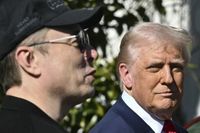On October 16, 2025, the White House reignited speculation in the aerospace community by reconsidering billionaire entrepreneur Jared Isaacman for the role of NASA Administrator—a position that would place him at the helm of the United States’ space ambitions during a period of unprecedented industry transformation. Isaacman, best known for leading the all-civilian Inspiration4 and Polaris Dawn missions, has become a prominent advocate for expanding the commercial space sector and redefining the relationship between public agencies and private enterprise.
Just two days earlier, on October 14, Isaacman addressed a packed auditorium at Lehigh University in Bethlehem, Pennsylvania, where he reflected on the current state of space exploration and the future of humanity’s reach beyond Earth. According to LehighDaily.com, Isaacman told students and faculty, “the space industry has reached ‘the healthiest time we have ever had’ with multiple companies launching rockets regularly and driving down costs through competition.” He pointed out that SpaceX, the company led by Elon Musk, now launches rockets every two days—a cadence that would have been unthinkable just a decade ago. Isaacman also highlighted the contributions of Blue Origin, Rocket Lab, and other emerging players, noting, “We have no other time in the history of human spaceflight where we can just rattle off so many names of companies that are building rockets.”
Isaacman’s perspective is shaped not only by his business ventures but by his personal journey. A Lehigh Valley native, he founded Shift4 Payments at 16 in his parents’ basement, later channeling his entrepreneurial energy into spaceflight. His leadership of the Inspiration4 mission in 2021 marked a milestone: the first orbital mission crewed entirely by private citizens. The mission raised $250 million for St. Jude Children’s Research Hospital, with $50 million of that coming from Elon Musk himself after the crew’s safe return.
Yet, despite his close working relationship with Musk and SpaceX, Isaacman has been clear about his independence. As reported by Aerospace Daily & Defense Report, he stated unequivocally, “if confirmed as NASA administrator, he would not be beholden to Elon Musk.” This assertion comes at a time when the boundaries between government agencies and private companies in space are increasingly blurred, and concerns about conflicts of interest are at the forefront of public debate. Isaacman’s stance seeks to reassure both policymakers and the public that NASA’s priorities would remain above private interests, even as it leans more heavily on commercial partnerships.
The White House’s renewed interest in Isaacman follows a tumultuous period. Months earlier, President Trump withdrew Isaacman’s initial nomination, a setback Isaacman addressed with characteristic candor at Lehigh University: “I’m a failed NASA nominee,” he admitted, but quickly added that his commitment to expanding academic and scientific involvement in space remains undiminished.
Isaacman’s vision for NASA is rooted in a pragmatic assessment of the agency’s role. He argues that, while private industry excels at scaling proven technologies and reducing costs, NASA should focus on what he calls “the near impossible”—breakthroughs that are too risky or expensive for any business to underwrite. “NASA needs to work on why we all contribute as taxpayers on the near impossible,” Isaacman explained. He cites nuclear propulsion as a prime example: a technology that could enable efficient travel between planets and produce fuel on Mars for return trips, but which requires the kind of sustained investment and risk tolerance that only a government agency can provide.
He also sees the development of a true space economy as essential to humanity’s long-term presence beyond Earth. “We need to figure out what, why we need space,” Isaacman said, emphasizing that an exciting future in space cannot rely solely on taxpayer funding. He pointed to the potential of mining helium-3 on the moon—a fuel for future fusion reactors—and extracting valuable minerals from asteroids. These ventures, he believes, could provide the economic justification for permanent settlements and industrial activity in space.
Isaacman’s advice for the next generation of aerospace professionals is equally forward-looking. He urged students to combine engineering expertise with artificial intelligence, predicting that AI will be crucial for analyzing the vast streams of sensor data generated by spacecraft, especially on deep space missions where communication delays make real-time control from Earth impossible. “This is absolutely the best time for it,” he told the Lehigh audience, highlighting how SpaceX’s Starship vehicle now offers more habitable volume than the International Space Station, opening new possibilities for long-duration missions and scientific research.
For those aspiring to enter the space industry but lacking the resources to start their own ventures, Isaacman offered practical guidance: “If you’ve identified the kind of general sector you want to be in, you work really hard, get into a company that you would be happy working at that you could learn from.” He emphasized the importance of gaining experience and building networks within established organizations before striking out independently.
Isaacman’s own experience aboard Inspiration4 left a profound impression on him, not just for its technical achievements, but for the human moments it fostered. He recounted how his crewmates expressed their passions in orbit: Dr. Sian “Leo” Proctor painted and wrote poetry, Hayley Arceneaux—who became the youngest American to orbit Earth—took photos beside the planet, and Christopher Sembroski played the ukulele. “It was kind of all those human moments that came together that made us a crew,” Isaacman reflected, underscoring the importance of personal connection and creativity in the harsh environment of space.
Lehigh University is also embracing this new era, having recently launched a master’s program in aerospace and space systems engineering. Faculty members are already conducting experiments aboard the International Space Station, studying how particles behave in zero gravity—a reminder that academic institutions continue to play a vital role in advancing space science and technology.
As the White House weighs its decision, the stakes for NASA’s leadership have never been higher. The agency stands at a crossroads, with the Artemis program aiming to return humans to the moon, commercial partners driving down launch costs, and new technologies on the horizon that could reshape humanity’s relationship with the cosmos. Whether or not Isaacman ultimately takes the reins at NASA, his vision and advocacy are helping to define the conversation about the future of space exploration—and the blend of public and private effort required to make it a reality.
With commercial spaceflight accelerating and the boundaries between government and industry continually evolving, the next chapter for NASA—and for those who dream of reaching the stars—remains wide open.





